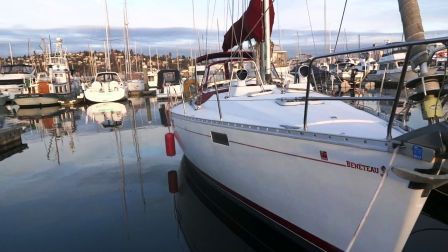Have you ever wondered what it is like living on a sailboat in a marina? Maybe you’re thinking about buying a sailboat and becoming a liveaboard. Maybe you want to lessen your rent. Maybe you want to become a minimalist and lesson your carbon foot print. All of these are good reasons to want to buy a sailboat and live in a marina, but there are many things you will want to consider before taking that leap.
I bought a sailboat in January of 2017 and moved aboard her that following April. I have been living aboard ever since. I bought the boat to start on the path of living my dream, to sail around the world. After over 2 years living on a sailboat in a marina, I can tell you a thing or two about what is good and what is not so good.
As I sat and thought about all the pros and cons of living on a sailboat in a marina, I also found that some of the items on the list were both, and neither. So rather than just putting out a list what is good and what is not so good, have formatted this blog into highlighted areas to consider and have left it to you to decide if it goes in the pro or con list.
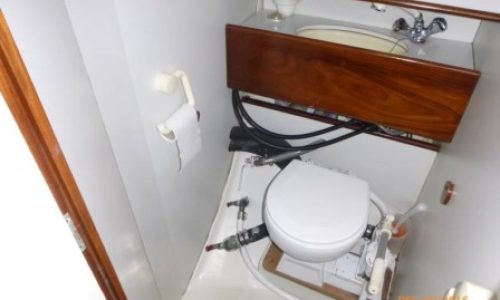
The Head (a.k.a. the bathroom)
This is probably one of the biggest, not in size, yet least thought about things that changes when it comes to moving onto a boat. That is why I am leading off with it. Even being a single guy, this is definitely on the con list for me.
Alright, let’s talk about size. Ask any girl, size matters, especially when it comes to bathrooms. I’m going to warn you, this is not a bathroom, it’s a head. Being a head means it is all things a bathroom is, but in the size of a shower stall. Yes, I said it correctly, a head is generally no larger than a shower stall, if you’re lucky, it will be the size of a full size shower.
There are two types of heads, a wet head and a dry head. I have one of each on my boat. The deference is a wet head has the shower in it, a dry head has the shower area separate. When it comes to living aboard in a marina, I opt for the dry head.
When you use a wet head, you have to basically take everything that can get wet out, even if it isn’t going to get wet, it will with the amount of humidity trapped in such a small area. Trust me, I lost a lot of toilet paper that absorbed a lot of moisture when I had to use the wet head after my shower pump died. To answer the next question, it was tucked away from where the water could get to it.
Speaking of pumps, keep in mind everything has to get pumped out of the boat; water and sewage. Yes, you get to become your own septic guy. Whatever gets pumped down the toilet, goes into a holding tank. From there you have to take the boat to a pump out and, well, pump it out.
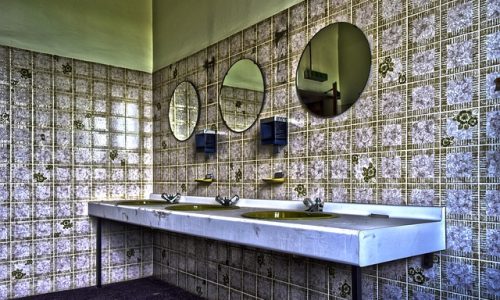
You can always alleviate this issue by using the marina bathrooms. When I was living on my sailboat in the marina in Seattle, Washington, using the marina bathrooms was actually nice. It was clean, warm, and well kept. Here in Sitka, Alaska, it is a little different. The harbor bathrooms are public restrooms and are not well kept at all. Worse is the majority of the homeless population use them to both relieve themselves and as a warm place to sleep or sleep it off. Luckily for me, the harbor is just down the road from where I work and I have access to that 24/7.
This is one of the biggest considerations to make, whatever you do, don’t be one of those who just pump their poo straight into the harbor. Not only is it illegal, it is just disgusting. Nothing will ruin your get together with friends quicker than watching a turd float by your boat while you’re eating.
The Shower

Related to, and often in the head, is the shower. When you move on to a boat, you will experience a change in how you shower. Again if you live in a marina that has clean and tighty bathrooms, use those, but I still suggest wearing flip-flops.
If you are showering on the boat, the first issue you need to overcome is the limitation of hot water. Most boats have relatively small hot water tanks, I am blessed with a very large 12 gallon tank. That said, the day of taking long hot showers if over.
The best way to shower on a boat is the military way. In basic training there were three shower heads and two spaces in between. Just like on a boat, you get wet, lather up, rinse off, wash hair, and rinse again. I have it down to get wet, lather up including hair, and rinse off. I average about 2 gallons of water per shower.
I know I have 12 gallons of hot water, but I also only have 90 gallons total of water. The more you use, the more you have to fill the tanks. In the summer it isn’t an issue, but in the winter, when the dock water is frozen, it can get interesting.
Also keep in mind, the more hot water you use, the more moisture is in the boat. The more moisture that is in the boat means there is more chance of mold and mildew starting to pop up. So you learn quick, short showers, with as little steam as possible.
The Galley (a.k.a. The Kitchen)
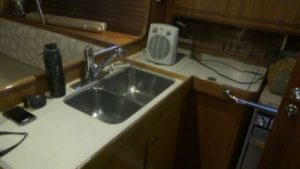
The galley is another big difference when living on a sailboat. It’s not so different from a normal kitchen, it is just condensed. Everything about a galley is smaller. Depending on the boat, you may also lose some things.
We’ll start with the stove. I have a good three burner stove with oven. Some boats don’t have an oven and some only have two burners. I rarely need more than two burners, but it is nice to have the option. Also the oven is very small comparatively. For Thanksgiving I have to be very careful about measuring my turkey to make sure it fits. Good thing I’m not cooking for the masses, I’d have to come up with another plan.
Another issue with the oven is most boat ovens are regulated by the size of the flame. They don’t have a set it and forget it temperature selection gauge. It really just takes some playing around to figure out what works best, but once you figure it out, it isn’t an issue any more. Until you figure it out though, keep a close eye on the temp or you will burn or under cook everything; I’ve done both.

Another difference you will find is in the refrigerator. The fridge in a galley is going to come in one of three configurations. You will have an icebox, a fridge, or a fridge/freezer combo. The majority of boats do not have front load fridges, this prevents accidental door opening during sailing and as some items shift in the swell, your food won’t end up on the sole of the boat.
Most fridge set-ups are going to be top load, which isn’t usually an issue, except, you will find that whatever you are after has sifted it’s way to the bottom. Maybe it’s just me, but it even happens when I’m tied to a dock.
I have seen a turn to more modern fridges in newer boats, but you will be hard pressed to find a boat that hold near what your home fridge does. I have been on some mega yachts with full size fridges, but beyond that, almost all the sailboats I have been on are top loading and small.
I am blessed and cursed to have both a fridge and freezer set up. The reason I say both, I love the freezer when I’m on the dock, but it eats power like mad when I sail away and anchor out.
Storage
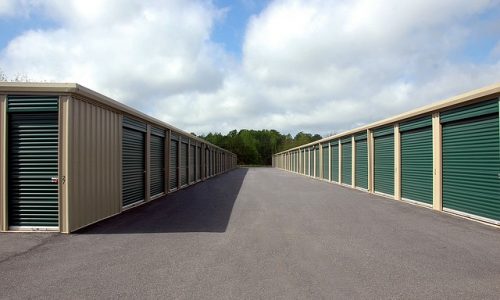
A good follow on for the galley is talking about overall storage. In the galley, and everywhere else on the boat, you are going to find you have limited storage. Overall each boat is designed differently and some have more storage then others. My sailboat is 38 feet long and has a moderate amount of storage for a boat its size, but I have also been on 36 foot boats with far more usable storage.
The reality of living on a sailboat in a marina is you will have to downsize. Downsizing isn’t really a bad thing. The whole idea of living the life of a liveaboard is to live a simpler life. That said you will have to do without some of your worldly goods.
In general the cabins (a.k.a. bedrooms) will have some storage for clothing and hanging cloths. The boat will have a hanging locker, much like a hall closet, but smaller. Most manufactures are good about utilizing the majority of free space to increase storage, but it also comes with some issues.
One of the issue is you will need to store things in sometimes not so easy places to get to. You will find with a little planning it isn’t a big deal. You put the stuff you use the least in the least accessible areas and the most used items in the most accessible area. The hardest part, for me at least, is remembering where you put what. The more storage areas you have, the harder it will be to remember where you put that last can of pasta sauce you know you have.
The next issue is what I call “Boat Tetris”. When you need to get to something, you have to unpack a whole compartment to get there and repack it when you get to what you needed. The fun part, just like when you take something out of the package it came in, it never seems to go back right.
There is also a lot you can do to expand on your storage space. I recently wrote a blog about 12 items that can dramatically increase what you can store in small areas. Check it out by clicking on the link.
Living Area
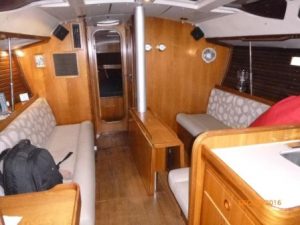
Right after storage, you will also note there is a lack of space in the living area. A prime example is my current boat. She has 2 cabins, 2 heads, a hanging locker, separate shower, galley, and the saloon (a.k.a. livingroom) all crammed into about 350 square feet.
This lack of space really isn’t a big deal when you think about it. I used to be a rent a 3 bedroom house kind of guy, even though I live alone. When you break it down, you spend about 90% of your time in about 30% of your homes square footage. You spend the other 10% of your time walking through the areas you don’t use to get to the other areas you do use.
You will have to make some concessions when living on a boat. Your 80 inch TV will become a thing of the past. Having a library of books, equipment for every hobby, and room to for all your tools; none of that exists, you’ll have to choose wisely what to hold on to. Sorry girls, if you have 37 pairs of shoes, you’ll have to lose those too.
You’ll have to narrow what you own down to a bare minimum. If you want more, you will need more boat. More boat will cost more, more to moor, more to maintain, and more to deal with. I am assuming the majority of people who read this will be looking for the opposite.
There are a lot of workarounds for the lack of space though. I have a cloth screen with a projector. I get to watch movies between 60 and 120 inches, depending on where I put the projector. I also have learned what I need, and what I can do without. I replace the majority of my books with a Kindle. My stereo is now my phone and 2 Bose speakers. I have a laptop instead of a desktop computer. Mostly I live within the confines of what I can have.
Amenities

The last big change is the amenities. When you’re living on a sailboat in a marina, you will not have some of the amenities you are used to. The high speed internet provider will not run a line down the dock to your boat. That means no cable either.
It is possible to put a dish on your boat and hotspots for mobile are less expensive than before. Additionally you can get satellite data now, but the price is still rather high.
It seems like such a small thing, but these days people are so attached to the web, it can be a major hurdle to overcome. The thought that you can’t watch the Super Bowl at home is enough for some to say “hell no, I won’t go.” For others it would be the inability to endlessly stream YouTube or Netflix. It seems like a small thing, but it really changes your way of life, though I think in a good way.
Wrapping it up
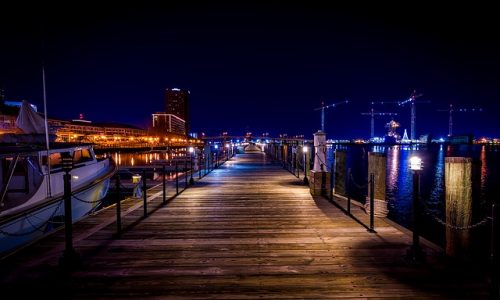
As you can see, there are a lot of changes when it comes to going from life on land to living on a sailboat in a marina. Some of those changes are minor and just take some getting used to. Others are major and will have you reorganizing your whole way of life.
In my opinion, it’s a good change though. You have less, but you also learn you don’t need so much. As I stated, you spend 90% of your time in 30% of your house.
So if you don’t use 70% of your house, why pay for it? I have also noticed with myself and every person I know, the bigger the house, the more stuff people store in it to fill the 70% they don’t use. Of all the things stored in those big houses, you guessed it, 70% or more of it is never used, touched, and in some cases, isn’t even known to exist.
When I moved aboard, I sold about 75% of my stuff. I am happier for it. I am living for less and feel I have so much more. I would only trade living on a sailboat in a marina for two things. One is a life at anchor, sailing around the world. The other is another story entirely, and one best left untold.
If you want to know more about living year round on a sailboat, check out my blog on living on a sailboat during the winter.
Don’t forget to follow me on social media so you don’t miss future posts!
Happy Sails!!

